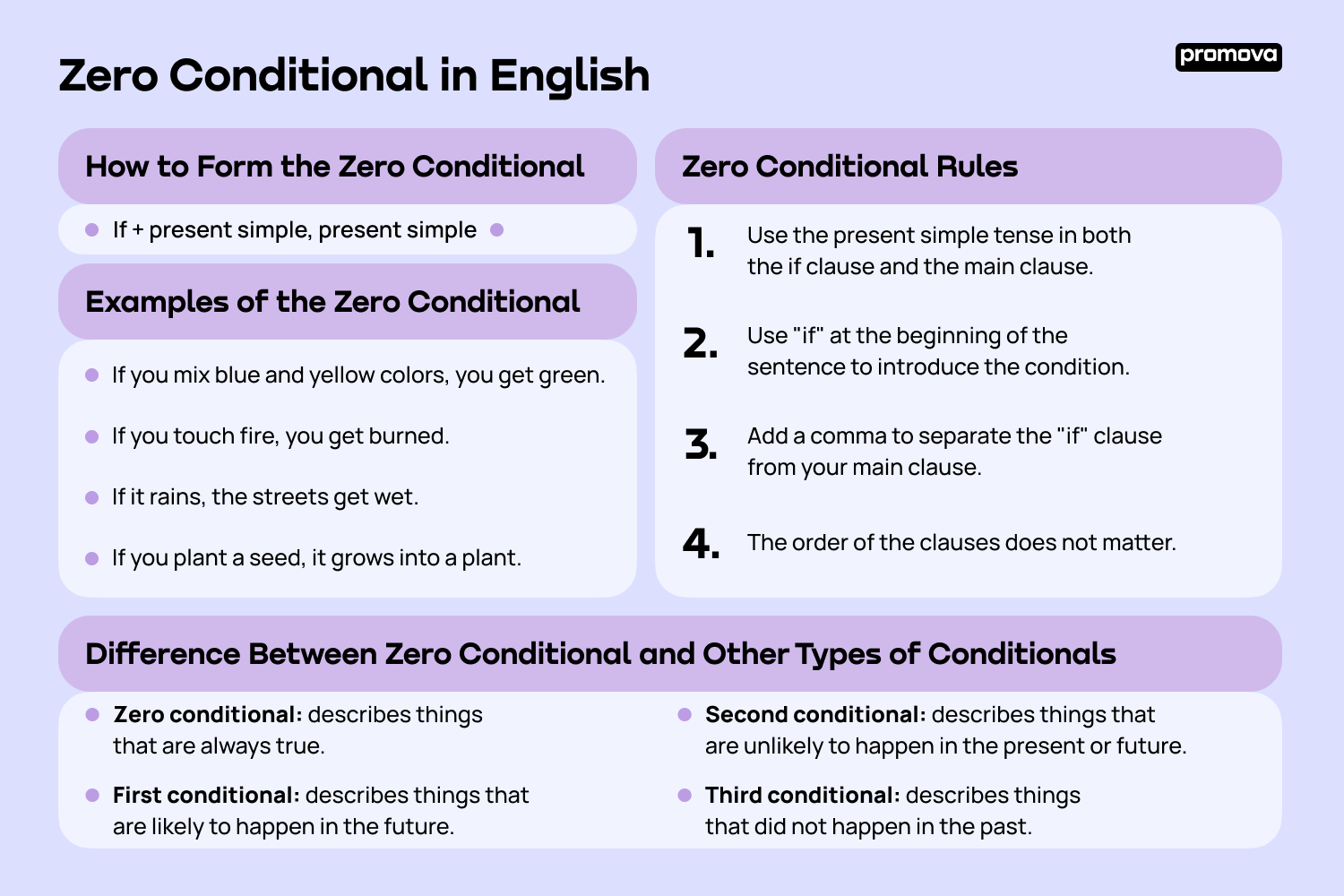Zero Conditional in English
Contents
If you are learning English, you have probably heard of conditionals. Conditionals are a specific grammatical structure used to talk about situations that may or may not happen. The zero conditional, in particular, is used to talk about things that are always true, no matter what the situation is. In this reference, we will explore the zero conditional in English, its rules, and how to use it correctly.
What does the Zero Conditional Mean?
The zero conditional, also known as the present real conditional, is used to talk about actions and events that are always true. It is used to describe a cause-and-effect relationship between two facts or events. The zero conditional is used to express a general truth, scientific facts, or instructions. Here are some examples:
- If you heat water up to 212 degrees Fahrenheit, it boils.
- If you don't eat, you get hungry.
- If the traffic is heavy, it takes longer to get to work.
As you can see, the zero conditional is used to describe something that always happens or is always true. The first part of the sentence (if clause) describes the condition, and the second part of the sentence (main clause) describes the consequence.

Examples of the Zero Conditional
- If you mix blue and yellow colors, you get green.
- If you touch fire, you get burned.
- If it rains, the streets get wet.
- If you plant a seed, it grows into a plant.
In each of these examples, the first part of the sentence describes the condition, and the second part of the sentence describes the consequence. The zero conditional is used to describe things that are always true, no matter what the situation is.
How to Form the Zero Conditional
The zero conditional is formed with the present simple tense in both the if clause and the main clause. Here is the formula for the zero conditional:
If + present simple, present simple
Examples of how to form the zero conditional:
- If I have free time, I read a book.
- If you eat too much, you feel sick.
- If it's hot outside, I wear shorts.
- If I'm bored, I watch TV.
- If you exercise regularly, you stay healthy.
Notice that the verb tense is always present simple in both the if clause and the main clause. This is because the zero conditional is used to describe things that are always true.
1
Difference Between Zero Conditional and Other Types of Conditionals
English has four types of conditionals: zero conditional, first conditional, second conditional, and third conditional. The difference between them lies in the likelihood of the event happening. Let's take a closer look:
- Zero conditional: describes things that are always true.
- First conditional: describes things that are likely to happen in the future.
- Second conditional: describes things that are unlikely to happen in the present or future.
- Third conditional: describes things that did not happen in the past.
The zero conditional is used to describe things that are always true, while the other types of conditionals are used to describe things that are less certain.
Zero Conditional Rules
Rules that you need to know when using the zero conditional:
- Use the present simple tense in both the if clause and the main clause.
- Use "if" at the beginning of the sentence to introduce the condition.
- Add a comma to separate the "if" clause from your main clause.
- The order of the clauses does not matter.
Let's take a look at some examples that follow these rules:
- If you don't brush your teeth, they get dirty.
- If it rains, the grass grows.
- If you mix red and green colors together, you get brown.
- If you don't water the plants, they die.
- If you exercise regularly, you feel better.
By following these rules, you can use the zero conditional correctly and effectively.
Common Mistakes
Despite its relative simplicity, the zero conditional can still be confusing for English learners. Common mistakes to avoid when using the zero conditional:
- Using the wrong verb tense: Remember to use the present simple tense in both the if clause and the main clause.
- Forgetting the comma: Always include a comma to separate the "if" clause from your main clause.
- Using "when" instead of "if": "When" is used to talk about things that are certain to happen, while "if" is used to talk about things that may or may not happen.
- Using the wrong word order: The order of the clauses does not matter in the zero conditional.
By avoiding these common mistakes, you can use the zero conditional correctly and avoid confusion.
Zero Conditional versus Other Types of Conditionals
As we mentioned earlier, there are four types of conditionals in English. Here are some examples of each type:
- Zero conditional: If you heat up ice, it melts.
- First conditional: If it rains tomorrow, I will stay inside.
- Second conditional: If I had the cash, I would buy a house.
- Third conditional: If I had studied harder, I would have passed the exam.
Each type of conditional is used to describe a different level of likelihood. The zero conditional is used to describe things that are always true, while the other types of conditionals are used to describe things that are less certain.
Summary
The zero conditional is a simple but important grammatical structure in English. It is used to describe things that are always true, and it can be used to express general truths, scientific facts, and instructions. By following the rules and avoiding common mistakes, you can use the zero conditional correctly and effectively.
Good luck using it in your own English - check out more handy references below to learn and improve!



Comments